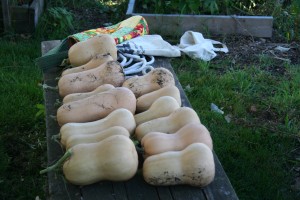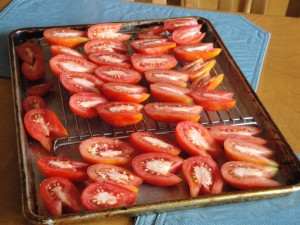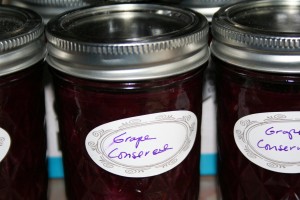Preserving the Harvest: The Options
With many garden crops ripening two or more weeks later than usual, the frenzy of preserving and storing has moved from August into September this year. For many gardeners, the tomatoes are just barely slowing down and we heard from an orchard owner recently that most apple varieties are about 20 days later than last year in ripening.
Whether you have tomatoes, fruit, squash or potatoes in abundance, there are a variety of ways of preserving the harvest. From least to most work, here are your options.

Store it. Some crops will remain edible and delicious for anywhere from two to eight months, if stored properly. My grandmother had a root cellar — an unheated basement where she kept carrots, potatoes, squash and other long-keeping vegetables. While our basement is pretty chilly, it’s not a root cellar, so I found that even winter squash (a long keeper) needed to be eaten up or processed by January. If you don’t have a cool, slightly moist basement, other options are to dig a hole outside, bury a garbage can or other critter-proof container and harvest from there or to use a cooler in the garage and check it frequently. University of Minnesota Extension has a great chart on this website with the proper conditions for storage and shelf life for a variety of fruits and vegetables.
Freeze it. After storing, freezing is the easiest way to save some of your garden produce for winter eating. Some foods such as raspberries can simply be frozen whole. Wash them lightly, let them drain on paper towels, and put the berries on a cookie sheet in the freezer. In a couple of hours, they’ll be frozen and you can pack them in plastic bags, removing just what you need for baking or fruit smoothies. Even tomatoes can be frozen whole, if you plan to use them only in cooking. This is a great way to handle them when you just can’t bear to eat one more or make one more batch of sauce. Other foods such as green beans and zucchini need a quick blanching before freezing. One thing to remember about freezing foods: Label, label, label. It’s very easy to forget when you froze something and most frozen vegetables taste best if consumed within eight months, if stored in a freezer that gets to 0 degrees.

Dry it. Drying removes the water from foods, making them less likely to spoil. Dehydrators are available in a wide range of prices from under $50 to almost $200. Dehydrating can be tricky and you might want to read up on it before trying it. Minnesotan Mary T. Bell of Lanesboro has several books (Food Drying with an Attitude is her latest) and offers drying supplies at www.drystore.com. While oven-dried tomatoes taste sweet and delicious, they usually are not dry enough to store outside of the refrigerator or freezer.
Ferment it. We’re hearing about more and more foodies and gardeners trying fermentation. The good bacteria that naturally exist in fermented sauerkraut, fermented pickles, kim-chi and other lacto-fermented foods is said to improve gut health. Fermenting is not difficult, but you may want to check out one of the many books now available on it or some websites with how-to instructions.

Can it. Canning is the most labor-intensive storage method, but homemade jam, delicious tomato sauce, red pepper relish, canned peaches, plums or applesauce and many of the other canned food items are so good that many gardeners happily do the work. When you can, follow the necessary food-safety procedures and make sure that all your jars have sealed properly. If you can push the center of the top in, just put that jar in the fridge and eat it first.

One Comment
-
Pingback: 150 Tips: Preserving the Harvest - Minnesota State Horticultural Society
Back to Blog